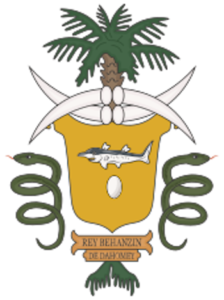
Dahomey Coat of Arms
*The Kingdom of Dahomey is celebrated on this date in 1625. This was a pre-colonial African kingdom located within present-day Benin that existed until 1904.
The oral story goes that Dakodonu considered their second king was granted permission by the Gedevi chiefs, the local rulers, to settle in the Abomey plateau. Dakodonu requested additional land from a prominent chief named Dan (or Da) to which the chief responded sarcastically "Should I open up my belly and build you a house in it?" For this insult, Dakodonu killed Dan and began the construction of his palace on the spot. The name of the kingdom is said to have derived from the incident: Dan=chief dan, xo=Belly, me=Inside of.
The Kingdom of Dahomey was established ethnically by the Fon people who had recently settled in the area (or were possibly a result of intermarriage between the Aja people and the local Gedevi). The foundational king for Dahomey is often considered to be Houegbadja who built the Royal Palaces of Abomey and began raiding and taking over towns outside of the Abomey plateau. Dahomey developed and became a regional power in the 18th century by conquering key cities on the Atlantic coast. For much of the 18th and 19th centuries, the Kingdom of Dahomey was a key regional state, eventually ending tributary status to the Oyo Empire. The Kingdom of Dahomey was an important regional power that had an organized domestic economy built on conquest and slave labor, significant international trade with white-Europeans, a centralized administration, taxation systems, and an organized military.
Notable in the kingdom were significant artwork, an all-female military unit called the Dahomey Amazons by European observers, and the elaborate religious practices of Vodun with the large festival of the Annual Customs of Dahomey which involved large scale human sacrifice. They traded prisoners, which they captured during wars and raids, and exchanged them with Europeans for goods such as knives, bayonets, firearms, fabrics, and spirits. Dahomey’s fate began with the 1884 Berlin Conference. It marked the highpoint of white European competition for territory in Africa, a process commonly known as the Scramble for Africa. The kingdom fell when the last king, Béhanzin, was defeated by France, leading to the country being annexed into the French colonial empire.